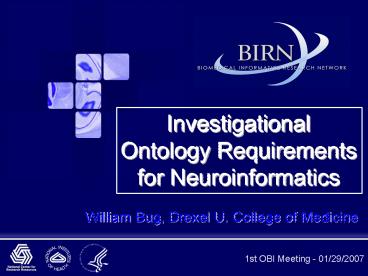Investigational Ontology Requirements for Neuroinformatics - PowerPoint PPT Presentation
1 / 17
Title:
Investigational Ontology Requirements for Neuroinformatics
Description:
Computational representation, manipulation, & analysis of experimental ... SHIVA (UCLA) SMART Atlas (UCSD) NeuroTerrain (Drexel) BIRN Atlas Interoperability API ... – PowerPoint PPT presentation
Number of Views:58
Avg rating:3.0/5.0
Title: Investigational Ontology Requirements for Neuroinformatics
1
Investigational Ontology Requirements for
Neuroinformatics
1st OBI Meeting - 01/29/2007
2
Neuroinformatics
- Definition
- Computational representation, manipulation,
analysis of experimental evidence captured during
neuroscientific investigation - Representational Domains
- Formal annotations of data - spatially-localizatio
n - Literature Informatics - IR --gt NLP
- CocoMac, BrainMap.org, Neuroscholar/NeuArt,
Arrowsmith - Models
- molecular, cellular, and systems - function
structure - Distilled Knowledge Resources
- Minimal KM NeuroNames,, SenseLab Terms, NIF
terminology, IUPHAR receptor/channel, PDSP Ki,
etc. - Ontologies FMA, CL, SAO, BIRNLex
3
Neuroinformatics
- Long-term Goal
- Promote neuro-wide, contextually relevant data
pooling for large-scale, multi-rez,
multi-modality meta-analysis - Requires formal representation of 3Es
- Evidence (PATO)
- Experimental context (OBI)
- Enviromental factors (EnvironmentO)
4
Neuroinformatics
- OBI Focus
- Community shared semantics for wide-variety of
investigational techniques - Investigational Domains
- Molecular (EM,molecular physiology, FISH, IHC,
receptor binding) - Cells Cell Components (EM, LM, histo, cell.
assays ) - Neuroanatomy (microscopy radiological imaging)
- Physiology (cellular system physiology)
- Behavior Cognitive (assessments)
5
Neuroinformatics
- All applies to single lab studies analyzed in
isolation - Large-scale neuroinformatics
- Lit. informatics
- BIRN
- NIF
- NITRC
- NeuroBase
- SenseLab
- MBL/GeneNetwork
- CCDB
- Atlases - LONI MAP, NT, Hof et al, Mouse
ImgCenter (Toronto) - Brain image data sets - GENSAT, ABA, Smart Atlas,
BrainMaps.org
6
BIRN Ontology Use
Critical to BIRN-wide
- semantically-mediated data integration
- automated data validity integrity
- data pooling/binning/sorting/modes
- data reduction
- analysis
- knowledge extraction, representation, discovery
(KE/KR/KD)
Integration across BIRN sites
- 29 locations - multiple labs/site
- with the rest of the world
Supports access both by human experts algorithms
7
BIRN Ontology Task Force (BIRN OTF)
Goals
- Develop ontology usage policies and procedures
for BIRN participants
- Biomedical ontology development community outreach
- Monitor community activity, participate
disseminate
- Educate BIRN participants on the use, development
and importance of ontologies
- Promote and develop cross test bed ontology
frameworks to support KE/KR/KD for animal models
and human disease
8
BIRN OTF
Personnel
BIRN-wide Representation
- BIRN-CC
- Jeff Grethe (UCSD)
BIRN-CC Scientific Coord. co-Inv.
- Amarnath Gupta (UCSD)
BIRN-CC co-Inv.- BIRN Mediator
- MBIRN
- Christine Fennema-Notestine (UCSD)
- David Kennedy (MGH)
- FBIRN
- Jessica Turner (UCI)
- mBIRN
- Maryann Martone (UCSD)
- Bill Bug (Drexel U.)
- NIH NCRR/NCBO
co-chair
- Carol Bean (NIH)
honorary
- Daniel Rubin (SMI, Stanford U.)
9
BIRN OTF
Work-in-progress
- BIRN IT Infrastructure maturing
- Intra-BIRN and external collaborative practice
maturing
- Broad spectrum of neuroimage-related tools data
- software APIs for handling files - many
image-specific
- spatially-mapped neuro-data sets
- visualization, spatial normalization analysis
- workflow - models of computation (e.g., Kepler,
OpenWFE)
- BIRN ontology use
- cross modality techniques, curatorial metadata,
harvest low KM terms stay in sync, image
annotation, cross-species, OWLMediation
10
BIRN OTF
Best Practices
- if ontology exists for required knowledge domain
- re-use it
- biomedical KE/KR/KD has developed considerable
lexical ontological sophistication over the
last decade
- re-use formalisms tools as well (e.g., OWL,
SKOS, PaTO-OBI, etc.)
- unfortunately, some existing ontologies
- dont exist yet for all neuroscience domains -
e.g., physiology, cognition
- conflate/pre-coordinate entities requiring
cleansing beyond our definition of re-use
- cover required domains but in a manner not
fitting a neuroscience context
- use incompatible formalisms
- Need for neuroinformatic outreach
- Many of the caveats above are being addressed in
last few years - our participation would help
hasten this effort in a way useful to
large-scale, field-wide semantically-driven
neuroinformatic query systems
11
BIRN OTF
Best Practices
- Need to start semantic annotation in BIRN NOW -
therefore
- systematically collect research lexicon in use by
40 BIRN labs
- re-use ontologies in current form if feasible -
even if not ontologically ideal
- represent formally using Protégé-OWL
- follow community best-practices, and try to be
formally precise in constructing the semantic
graph so as to promote clarity and lexical
separation
- use specific curatorial typing (i.e., BIRN
curation status tags)
- use normative lexical variant typing (e.g., SKOS)
- Should hasten effort to ultimately translate
BIRNLex into a collection of formal BIRN
ontologies
- The multi-scale investigation of neurological
disease ontology framework
12
BIRN OTF
Knowledge resource development
- BIRN Project - comprehensive Use Case set
- Excellent test bed for research use of biomedical
experiment ontology integrated with other
ontologies in the biomedical domain
- BIRN OTF gathers, collates, publishes Use Cases
across test beds
- Ontology tools ontology use rapidly evolving
- BONFIRE (tool)
- BIRNLex (lexicon)
- MIND (ontology) - only what we cannot re-use
- BIRN ontology best practices - social
engineering
13
BIRN OTF
Work-in-progress
- How to actually link to use external ontologies
- when and how to resolve URIs
- BIRN Investigational Ontology elements
- device, assay, reagent, protocol
- thinnest component of BIRNLex now - granularity
non-uniform
- began with FuGO/OBI from March 2006
- some additional curation required to cleanse
current experiment entities - shows UMLS origins
- still hope to get most of what we require from
OBI, PaTO, ChEBI, GO, CL-O, Neuro-FMA, etc.
14
Mouse BIRN
Experiment Ontology Requirements
Use Cases illustrating experiment ontology
requirements
15
Brain Atlas System Integration
BIRN Atlas Interoperability API
SMART Atlas (UCSD)
NeuroTerrain (Drexel)
SHIVA (UCLA)
BIRN Atlas Interoperability API
MBAT (BIRN)
16
(No Transcript)
17
(No Transcript)

